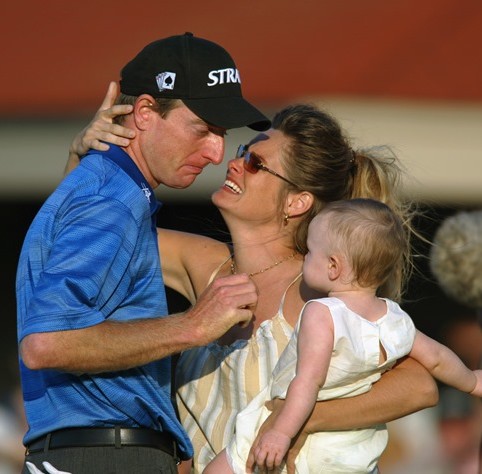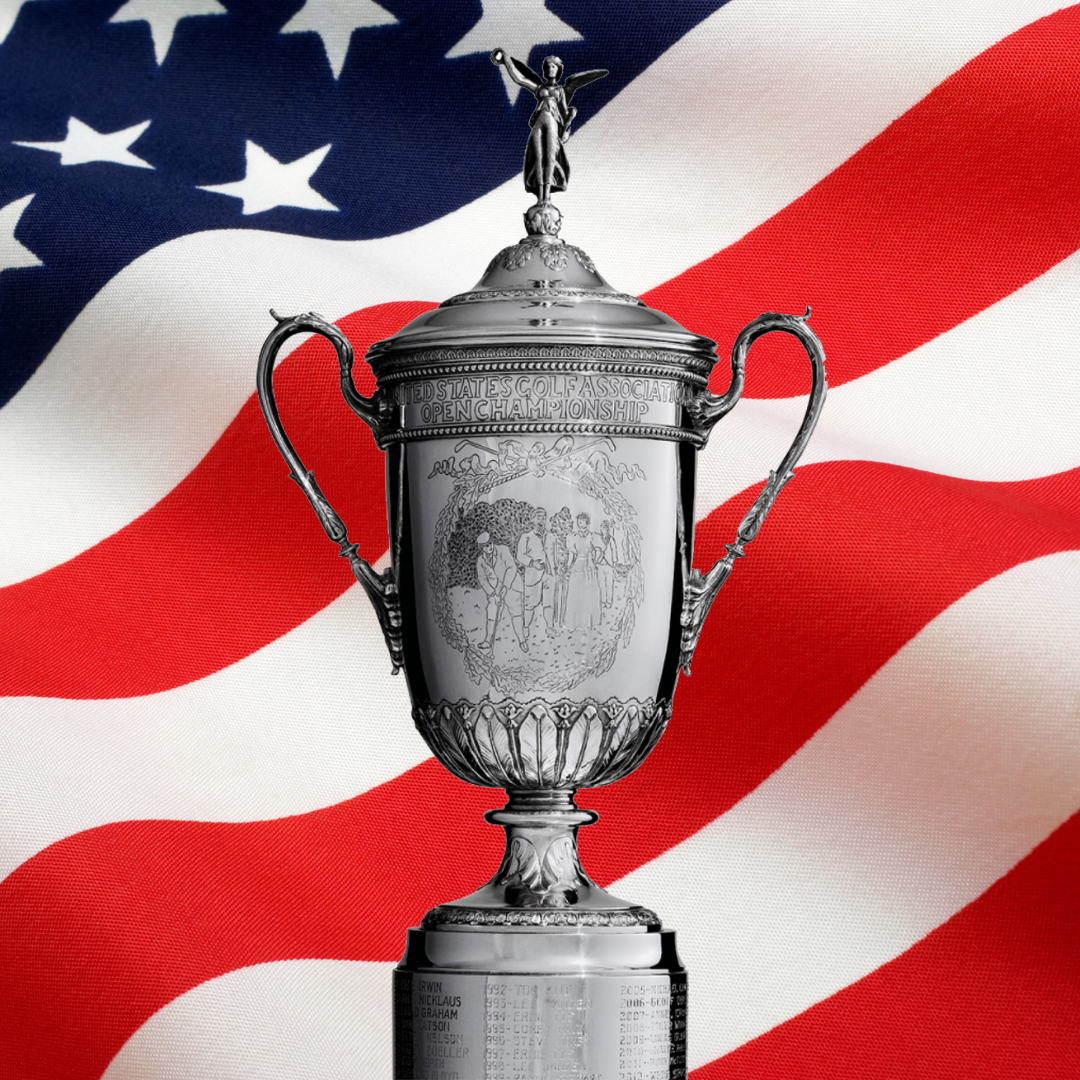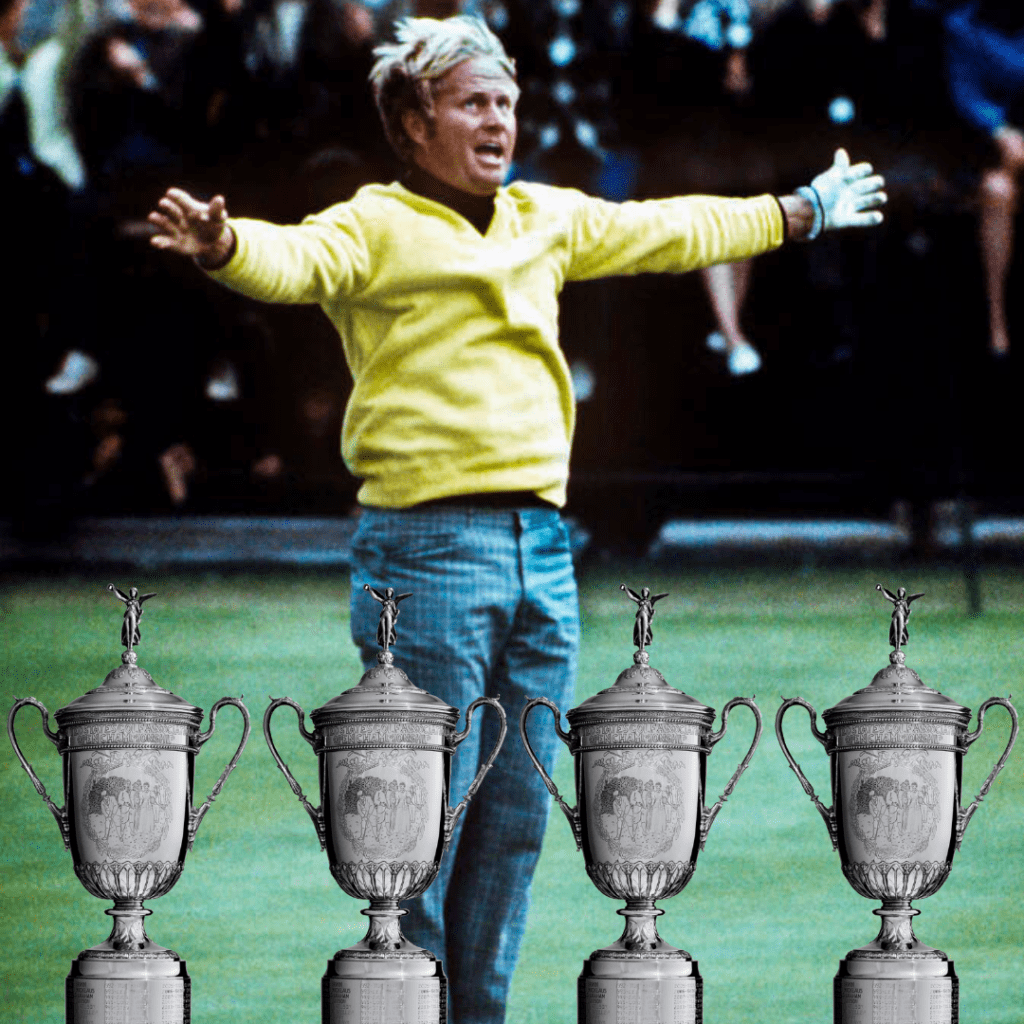The US Open – Everything you need to know!

DISCLOSURE: THIS POST MAY CONTAIN AFFILIATE LINKS, MEANING I GET A COMMISSION IF YOU DECIDE TO MAKE A PURCHASE THROUGH MY LINKS, AT NO COST TO YOU. PLEASE READ MY DISCLOSURE FOR MORE INFO.
A Storied History of the US Open
The United States Open (US Open) was first hosted in 1895, making it the second oldest major in golf behind the British Open. The first event was held at Newport Country Club in Newport, Rhode Island and featured 11 golfers competing over 36 holes for the gold medal and $150. The event was changed to 72 holes starting in 1898 and has remained that way ever since. The early period of the U.S. Open was marked by domination from British golfers, as there were more British professionals at the time than Americans. The first American-born champion came in 1911 with John McDermott, and since that time Americans have come to dominate the event in their own right.
A Father’s Day Tradition
The U.S. Open has become a Father’s Day tradition of sorts within the United States. As the second major of every year after the Masters, the U.S. Open is held by the USGA in mid-June, with the final round being played on the third Sunday of the month which is Father’s Day in America. This has produced some memorable family moments.

📸 credit: Donald Miralle/Getty Images)
There have been some rare instances where the event was held on a different month, with the most recent being the 2020 U.S. Open held in mid-September of that year.
Another unique feature in the history of the U.S. Open comes in regard to its playoff format. Unlike the other three majors, if there was a tie after 72 holes on Sunday the players who are tied traditionally played a full 18 holes on Monday instead of a sudden death playoff. There has been a total of 33 playoffs in the major’s history. In 2018 this was changed to a two hole playoff, on the Sunday. If the players are still tied after those two holes there is a sudden death where the golfer that wins the next hole wins the major.
A True Challenge
Aside from the Father’s Day finish and playoff format, what makes the U.S. Open truly unique is its courses. As Jack Nicklaus stated best about the U.S. Open, “the tournament is a complete examination of the golfer.” What he meant is that the courses are set up in a way to be a true challenge for golfers, with many of the finishes at the event being over par. Courses are not only lengthened considerably (Torrey Pines in 2021 was 7,800 yards), but the fairways are more narrow and the rough is grown out to make it more difficult and penalising for golfers who are not accurate off the tee. Not only this, but the greens are made faster to provide an even greater challenge to the best golfers in the world.

The philosophy of the USGA is to make the U.S. Open the toughest challenge that golfers will face every year, and as such they are not only highly selective in the golf courses they choose but also willing to make numerous changes to the course if necessary ahead of time to meet the standards the organisation has.
A Unique Watching Experience
The challenging course setups also make the US Open it one of the most interesting events for fans of sport to watch. It can seem daunting to watch golfers drive the golf ball nearly 350 yards and make putts from seemingly anywhere on the green, but the U.S. Open brings these golfers back down the Earth. Amateur golfers can certainly relate to watching these golfers struggling to make pars and bogeys on practically every hole, and that is what makes the U.S. Open both fun and unique to watch.
A Work of Art
The US Open Golf Trophy, also known as the U.S. Open Championship Trophy, is one of the most prestigious prizes in professional golf. Surprisingly, unlike many other major sports trophies, it doesn’t have an individual name.

The current trophy is a work of art, designed by the legendary golf course architect, Donald Ross, in 1947. Ross also designed some of the most famous golf courses in the world, including Pinehurst No. 2 and Oak Hill Country Club, creating a unique design that has become an iconic symbol of the U.S. Open. The original trophy was destroyed in a fire in 1946 after Lloyd Mangrum (that year’s winner) took it to his home club.
The new trophy is made of sterling silver and stands 18 inches tall and six inches in diameter. Lifting the trophy isn’t too difficult, it only weighs 8.5 pounds (3.9 kgs). On one side of the trophy is an engraving of the words “United States Golf Association Open Championship.” Beneath it, an engraved laurel wreath wraps a scene of four golfers. The lid of the trophy is topped by a winged, female figure representing victory. The US Open winner’s names are all engraved around the base.
One of the unique features of the U.S. Open Trophy is that the winner only gets to keep it for a year. After that, the trophy is returned to the United States Golf Association (USGA), who then present it to the next year’s winner. The winner does get a gold medal (known as the Jack Nicklaus Medal) to keep and both them and their host club are allowed to order one replica trophy each from the USGA.
What is the purse for the US Open Golf Championship?
The US Open Golf Championship has one of the largest purses in world sport and the biggest pot of golf’s four majors. The Prize fund varies from year to year, but it has consistently grown over time. Here’s the prize pot and 1st place winnings for the last few years:
2024 – $21.5m pot – Winner Bryson DeChambeau $4.3m
2023 – $20m pot – Winner Wyndham Clark received $3.6m
2022 – $17.5m pot – Winner Matt Fitzpatrick received $3.15
2021 – $12.5m pot – Winner Jon Rahm received $2.25m
2020 – $12.0m pot – Winner Bryson DeChambeau received $2.25m
With such a large purse at stake, it’s no surprise that the US Open is one of the most highly anticipated golf tournaments each year.
How does the US Open differ from other major golf championships?
The U.S. Open is one of the four major golf championships, along with the Masters, the Open Championship (British Open), and the PGA Championship. While each of these tournaments is highly prestigious, the U.S. Open stands out in a few key ways.
First and foremost, the U.S. Open is known for its difficulty. The tournament is traditionally held on courses that are specifically designed to be challenging, with narrow fairways, deep bunkers, and thick rough. The greens are usually lightning-fast and feature complex undulations, making putting a real test of skill. As a result, the U.S. Open is often won by players who excel at accuracy and precision, rather than raw power.
Another way in which the U.S. Open differs from other major championships is in its focus on pars. While other tournaments may reward aggressive play and birdies, the U.S. Open is often won by players who are able to consistently make pars. This is due in part to the difficulty of the courses, but also to the fact that the U.S. Open traditionally features narrow fairways and small greens, making it difficult for players to hit approach shots close to the hole.
Finally, the U.S. Open is unique in that it places a greater emphasis on history and tradition than many other tournaments. The event has been held annually since 1895, and many of the greatest players in golf history have won the tournament. The U.S. Open also features a number of unique traditions, such as the presentation of the trophy on the 18th green, and the playing of “The Star-Spangled Banner” during the winner’s ceremony.
How do golfers qualify for the US Open Golf Championship?
There are several ways for golfers to earn a spot in the U.S. Open field, ranging from exemption categories to qualifying rounds. Let’s take a closer look at each of these methods:
Exemption Categories
Exemption categories are pre-determined groups of players who are exempt from having to qualify for the U.S. Open. These categories have changed throughout the years but the categories for 2023 (listed on US Open Official Website) qualification are:
- F-1. Winners of the U.S. Open Championship the last 10 years (2013-22)
- F-2. From the 2022 U.S. Open Championship, the 10 lowest scorers and anyone tying for 10th place
- F-3. Winner of the 2022 U.S. Senior Open Championship
- F-4. Winner of the 2022 U.S. Amateur Championship
- F-5. Winners of the 2022 U.S. Junior Amateur and U.S. Mid-Amateur Championships, and the 2022 U.S. Amateur runner-up (must be an amateur)
- F-6. Winners of the Masters Tournament (2019-2023)
- F-7. Winners of the PGA Championship (2018-2023)
- F-8. Winners of The Open Championship, conducted by The R&A (2018-2022)
- F-9. Winners of The Players Championship (2021-2023)
- F-10. Winner of the 2022 European Tour BMW PGA Championship
- *F-11. Those players who qualified and were eligible for the season-ending 2022 Tour Championship
- F-12. Multiple winners of PGA Tour events that award a full-point allocation for the FedExCup, from the conclusion of the 2022 U.S. Open (June 16-19) to the initiation of the 2023 U.S. Open
- *F-13. The top five players in the 2022-23 FedExCup standings as of May 22, 2023, who are not otherwise exempt
- *F-14. The points leader from the 2022 Korn Ferry Tour season using combined points earned on the Korn Ferry Tour Regular Season Points List and points earned in the Korn Ferry Tour Finals
- **F-15. The top two players from the final 2022 DP World Tour Rankings who are not otherwise exempt as of May 22, 2023
- **F-16. The top player on the 2023 Race to Dubai Rankings as of May 22, 2023, who is not otherwise exempt
- **F-17. The top two finishers from the 2023 DP World Tour U.S. Open Qualifying Series, who are not otherwise exempt
- F-18. Winner of the 2022 Amateur Championship, conducted by The R&A (must be an amateur)
- F-19. Winner of the 2022 Mark H. McCormack Medal (Men’s World Amateur Golf Ranking) (must be an amateur)
- F-20. Winner of the 2023 NCAA Division I Men’s Golf Championship (must be an amateur)
- F-21. Winner of the 2023 Latin America Amateur Championship (must be an amateur)
- F-22. From the current Official World Golf Ranking, the top 60 point leaders and ties as of May 22, 2023
- F-23. From the current Official World Golf Ranking, the top 60 point leaders and ties as of June 12, 2023 (if not previously exempt)
- F-24. Special exemptions selected by the USGA
*For Exemptions F-11, F-13 and F-14, players must be considered eligible per PGA Tour regulations at the time the exemption is determined to qualify for the exemption.
**For Exemptions F-15, F-16 and F-17, players must be in DP World Tour membership at the time the exemption is determined to qualify for the exemption.
Local Qualifying
For players who aren’t exempt, the first stage of qualifying is local qualifying. This stage is open to any professional or amateur golfer with a USGA Handicap Index of 1.4 or lower. Local qualifying is conducted at more than 100 sites across the United States, typically in May.
Players who advance from local qualifying move on to sectional qualifying.
Sectional Qualifying
Sectional qualifying is the final stage of qualifying and is open to players who successfully advance from local qualifying. The sectional qualifying is typically held about a week before the U.S. Open and takes place at several locations around the United States and internationally.
The 36-hole sectional qualifying takes place at several sites across the United States, while international sectional qualifying is held at a single location outside the United States.
The number of spots available at sectional qualifying varies from year to year, but typically around half of the U.S. Open field is filled by players who qualified through sectional qualifying.
In total, the U.S. Open field consists of approximately 156 players, with the exact number varying from year to year.
Who has won the US Open?
Many distinguished golfers have had the pleasure of lifting the U.S. Open Championship Trophy. The list reads like a who’s who of golf. Willie Anderson, Bobby Jones, Ben Hogan and Jack Nicklaus have each won the US Open a record four times, followed by Tiger Woods and Hale Irwin who have won it three times each. Below is also a list of previous winners and venues of the US Open.
| Year | Country | Champion | Course | Total score | Score to Par |
| 1895 | England | Horace Rawlins | Newport Country Club | 173 | n/a |
| 1896 | Scotland | James Foulis | Shinnecock Hills | 152 | n/a |
| 1897 | England | Joe Lloyd | Chicago Golf Club | 162 | n/a |
| 1898 | Scotland | Fred Herd | Myopia Hunt Club | 328 | n/a |
| 1899 | Scotland | Willie Smith | Baltimore Country Club | 315 | n/a |
| 1900 | Jersey | Harry Vardon | Chicago Golf Club | 313 | n/a |
| 1901 | Scotland | Willie Anderson | Myopia Hunt Club | 331 | n/a |
| 1902 | Scotland | Laurie Auchterlonie | Garden City Golf Club | 307 | n/a |
| 1903 | Scotland | Willie Anderson | Baltusrol Golf Club | 307 | n/a |
| 1904 | Scotland | Willie Anderson | Glen View Club | 303 | n/a |
| 1905 | Scotland | Willie Anderson | Myopia Hunt Club | 314 | n/a |
| 1906 | Scotland | Alex Smith | Onwentsia Club | 295 | n/a |
| 1907 | Scotland | Alec Ross | Philadelphia Cricket Club | 302 | n/a |
| 1908 | Scotland | Fred McLeod | Myopia Hunt Club | 322 | n/a |
| 1909 | England | George Sargent | Englewood Golf Club | 290 | +2 |
| 1910 | Scotland | Alex Smith | Philadelphia Cricket Club | 298 | +6 |
| 1911 | US | John McDermott | Chicago Golf Club | 307 | +3 |
| 1912 | US | John McDermott | Country Club of Buffalo | 294 | +6 |
| 1913 | US | Francis Ouimet | The Country Club, Brookline | 304 | +12 |
| 1914 | US | Walter Hagen | Midlothian Country Club | 290 | +2 |
| 1915 | US | Jerome Travers | Baltusrol Golf Club | 297 | +1 |
| 1916 | US | Chick Evans | The Minikahda Club | 286 | −2 |
| 1917 | — | None | — | — | — |
| 1918 | — | None | — | — | — |
| 1919 | US | Walter Hagen | Brae Burn Country Club | 301 | +17 |
| 1920 | Jersey | Ted Ray | Inverness Club | 295 | +7 |
| 1921 | England | Jim Barnes | Columbia Country Club | 289 | +9 |
| 1922 | US | Gene Sarazen | Skokie Country Club | 288 | +8 |
| 1923 | US | Bobby Jones | Inwood Country Club | 296 | +8 |
| 1924 | England | Cyril Walker | Oakland Hills | 297 | +9 |
| 1925 | Scotland | Willie Macfarlane | Worcester Country Club | 291 | +7 |
| 1926 | US | Bobby Jones | Scioto Country Club | 293 | +5 |
| 1927 | US | Tommy Armour | Oakmont Country Club | 301 | +13 |
| 1928 | US | Johnny Farrell | Olympia Fields | 294 | +10 |
| 1929 | US | Bobby Jones | Winged Foot Golf Club | 294 | +6 |
| 1930 | US | Bobby Jones | Interlachen Country Club | 287 | −1 |
| 1931 | US | Billy Burke | Inverness Club | 292 | +8 |
| 1932 | US | Gene Sarazen | Fresh Meadow Country Club | 286 | +6 |
| 1933 | US | Johnny Goodman | North Shore Country Club | 287 | −1 |
| 1934 | US | Olin Dutra | Merion Golf Club | 293 | +13 |
| 1935 | US | Sam Parks, Jr. | Oakmont Country Club | 299 | +11 |
| 1936 | US | Tony Manero | Baltusrol Golf Club | 282 | −6 |
| 1937 | US | Ralph Guldahl | Oakland Hills | 281 | −7 |
| 1938 | US | Ralph Guldahl | Cherry Hills | 284 | E |
| 1939 | US | Byron Nelson | Philadelphia Country Club | 284 | +8 |
| 1940 | US | Lawson Little | Canterbury Golf Club | 287 | −1 |
| 1941 | US | Craig Wood | Colonial Country Club | 284 | +4 |
| 1942 | — | None | — | — | — |
| 1943 | — | None | — | — | — |
| 1944 | — | None | — | — | — |
| 1945 | — | None | — | — | — |
| 1946 | US | Lloyd Mangrum | Canterbury Golf Club | 284 | −4 |
| 1947 | US | Lew Worsham | St. Louis Country Club | 282 | −2 |
| 1948 | US | Ben Hogan | Riviera Country Club | 276 | −8 |
| 1949 | US | Cary Middlecoff | Medinah Country Club | 286 | +2 |
| 1950 | US | Ben Hogan | Merion Golf Club | 287 | +7 |
| 1951 | US | Ben Hogan | Oakland Hills | 287 | +7 |
| 1952 | US | Julius Boros | Northwood Club | 281 | +1 |
| 1953 | US | Ben Hogan | Oakmont Country Club | 283 | −5 |
| 1954 | US | Ed Furgol | Baltusrol Golf Club | 284 | +4 |
| 1955 | US | Jack Fleck | Olympic Club | 287 | +7 |
| 1956 | US | Cary Middlecoff | Oak Hill Country Club | 281 | +1 |
| 1957 | US | Dick Mayer | Inverness Club | 282 | +5 |
| 1958 | US | Tommy Bolt | Southern Hills | 283 | +3 |
| 1959 | US | Billy Casper | Winged Foot Golf Club | 282 | +2 |
| 1960 | US | Arnold Palmer | Cherry Hills | 280 | −4 |
| 1961 | US | Gene Littler | Oakland Hills | 281 | +1 |
| 1962 | US | Jack Nicklaus | Oakmont Country Club | 283 | −1 |
| 1963 | US | Julius Boros | The Country Club, Brookline | 293 | +9 |
| 1964 | US | Ken Venturi | Congressional Country Club | 278 | −2 |
| 1965 | S Africa | Gary Player | Bellerive Country Club | 282 | +2 |
| 1966 | US | Billy Casper | Olympic Club | 278 | −2 |
| 1967 | US | Jack Nicklaus | Baltusrol Golf Club | 275 | −5 |
| 1968 | US | Lee Trevino | Oak Hill Country Club | 275 | −5 |
| 1969 | US | Orville Moody | Champions Golf Club | 281 | +1 |
| 1970 | England | Tony Jacklin | Hazeltine National Golf Club | 281 | −7 |
| 1971 | US | Lee Trevino | Merion Golf Club | 280 | E |
| 1972 | US | Jack Nicklaus | Pebble Beach | 290 | +2 |
| 1973 | US | Johnny Miller | Oakmont Country Club | 279 | −5 |
| 1974 | US | Hale Irwin | Winged Foot Golf Club | 287 | +7 |
| 1975 | US | Lou Graham | Medinah Country Club | 287 | +3 |
| 1976 | US | Jerry Pate | Atlanta Athletic Club | 277 | −3 |
| 1977 | US | Hubert Green | Southern Hills | 278 | −2 |
| 1978 | US | Andy North | Cherry Hills | 285 | +1 |
| 1979 | US | Hale Irwin | Inverness Club | 284 | E |
| 1980 | US | Jack Nicklaus | Baltusrol Golf Club | 272 | −8 |
| 1981 | Australia | David Graham | Merion Golf Club | 273 | −7 |
| 1982 | US | Tom Watson | Pebble Beach | 282 | −6 |
| 1983 | US | Larry Nelson | Oakmont Country Club | 280 | −4 |
| 1984 | US | Fuzzy Zoeller | Winged Foot Golf Club | 276 | −4 |
| 1985 | US | Andy North | Oakland Hills | 279 | −1 |
| 1986 | US | Raymond Floyd | Shinnecock Hills | 279 | −1 |
| 1987 | US | Scott Simpson | Olympic Club | 277 | −3 |
| 1988 | US | Curtis Strange | The Country Club, Brookline | 278 | −6 |
| 1989 | US | Curtis Strange | Oak Hill Country Club | 278 | −2 |
| 1990 | US | Hale Irwin | Medinah Country Club | 280 | −8 |
| 1991 | US | Payne Stewart | Hazeltine National Golf Club | 282 | −6 |
| 1992 | US | Tom Kite | Pebble Beach | 285 | −3 |
| 1993 | US | Lee Janzen | Baltusrol Golf Club | 272 | −8 |
| 1994 | S Africa | Ernie Els | Oakmont Country Club | 279 | −5 |
| 1995 | US | Corey Pavin | Shinnecock Hills | 280 | E |
| 1996 | US | Steve Jones | Oakland Hills | 278 | −2 |
| 1997 | S Africa | Ernie Els | Congressional Country Club | 276 | −4 |
| 1998 | US | Lee Janzen | Olympic Club | 280 | E |
| 1999 | US | Payne Stewart | Pinehurst Resort | 279 | −1 |
| 2000 | US | Tiger Woods | Pebble Beach | 272 | −12 |
| 2001 | S Africa | Retief Goosen | Southern Hills | 276 | −4 |
| 2002 | US | Tiger Woods | Bethpage Black | 277 | −3 |
| 2003 | US | Jim Furyk | Olympia Fields | 272 | −8 |
| 2004 | S Africa | Retief Goosen | Shinnecock Hills | 276 | −4 |
| 2005 | NZ | Michael Campbell | Pinehurst Resort | 280 | E |
| 2006 | Australia | Geoff Ogilvy | Winged Foot Golf Club | 285 | +5 |
| 2007 | Argentina | Ángel Cabrera | Oakmont Country Club | 285 | +5 |
| 2008 | US | Tiger Woods | Torrey Pines | 283 | −1 |
| 2009 | US | Lucas Glover | Bethpage Black | 276 | −4 |
| 2010 | N Ireland | Graeme McDowell | Pebble Beach Golf Links | 284 | E |
| 2011 | N Ireland | Rory McIlroy | Congressional Country Club | 268 | −16 |
| 2012 | US | Webb Simpson | Olympic Club | 281 | +1 |
| 2013 | England | Justin Rose | Merion Golf Club | 281 | +1 |
| 2014 | Germany | Martin Kaymer | Pinehurst Resort | 271 | −9 |
| 2015 | US | Jordan Spieth | Chambers Bay | 275 | −5 |
| 2016 | US | Dustin Johnson | Oakmont Country Club | 276 | −4 |
| 2017 | US | Brooks Koepka | Erin Hills | 272 | −16 |
| 2018 | US | Brooks Koepka | Shinnecock Hills | 281 | +1 |
| 2019 | US | Gary Woodland | Pebble Beach Golf Links | 271 | −13 |
| 2020 | US | Bryson DeChambeau | Winged Foot Golf Club | 274 | −6 |
| 2021 | Spain | Jon Rahm | Torrey Pines | 278 | −6 |
| 2022 | England | Matt Fitzpatrick | The Country Club, Brookline | 274 | −6 |
| 2023 | US | Wyndham Clark | The Los Angeles Country Club | 270 | -10 |
| 2024 | US | Bryson DeChambeau | Pinehurst Resort | 274 | -6 |
| 2025 | Oakmont Country Club | ||||
| 2026 | Shinnecock Hills | ||||
| 2027 | Pebble Beach Golf Links | ||||
| 2028 | Winged Foot Golf Club |

Multiple US Open Winners
There are 23 golfers that have won the US Open more than once.
| Country | Golfer | Total | Years |
| Scotland | Willie Anderson | 4 | 1901, 1903, 1904, 1905 |
| US | Ben Hogan | 4 | 1948, 1950, 1951, 1953 |
| US | Bobby Jones (a) | 4 | 1923, 1926, 1929, 1930 |
| US | Jack Nicklaus | 4 | 1962, 1967, 1972, 1980 |
| US | Hale Irwin | 3 | 1974, 1979, 1990 |
| US | Tiger Woods | 3 | 2000, 2002, 2008 |
| US | Julius Boros | 2 | 1952, 1963 |
| US | Billy Casper | 2 | 1959, 1966 |
| US | Bryson DeChambeau | 2 | 2020, 2024 |
| S Africa | Ernie Els | 2 | 1994, 1997 |
| S Africa | Retief Goosen | 2 | 2001, 2004 |
| US | Ralph Guldahl | 2 | 1937, 1938 |
| US | Walter Hagen | 2 | 1914, 1919 |
| US | Lee Janzen | 2 | 1993, 1998 |
| US | Brooks Koepka | 2 | 2017, 2018 |
| US | John McDermott | 2 | 1911, 1912 |
| US | Cary Middlecoff | 2 | 1949, 1956 |
| US | Andy North | 2 | 1978, 1985 |
| US | Gene Sarazen | 2 | 1922, 1932 |
| Scotland | Alex Smith | 2 | 1906, 1910 |
| US | Payne Stewart | 2 | 1991, 1999 |
| US | Curtis Strange | 2 | 1988, 1989 |
| US | Lee Trevino | 2 | 1968, 1971 |

Where is the US Open Golf Championship held?
The US Open Golf Championship is held at a different venue each year. Above you can see where the US Open has been held previously and where it has been decided that it will be held in the future.
How many times has Tiger Woods Won the US Open Golf Championship?
Tiger Woods has won the US Open 3 times. In 2000, 2002 and 2008.
Who has won the most US Open Golf Championships?
Four players have won the US Open a record four times. Willie Anderson, Ben Hogan, Bobby Jones and Jack Nicklaus.
When was the first US Open Golf Championship held?
The first US Open Golf Championship was held in 1895 at Newport Golf and Country Club in Rhode Island.
Where was the US Open Golf be held in 2024?
The 2024 US Open was held at the Pinehurst Resort (Course No. 2).
Where will the US Open Golf be held in 2025?
The 2025 US Golf Open will be held at Oakmont Country Club
Where will the US Open Golf be held in 2026?
In 2026 the US Open will be held at Shinnecock Hills Golf Club
Where will the US Open Golf be held in 2027?
The 2027 US Open will be held at Pebble Beach.
Where will the US Open Golf be held in 2028?
Winged Foot Golf Club will host the 2028 US Open Championship.
How many courses are used for the US Open Golf Championship?
Only one course is used each year to host the US Open Golf Championship. A different course is selected by the USGA each year, usually many years in advance to give the host time to plan the event.
How many rounds are played in the US Open Golf Championship?
The US Open is played over 4 rounds of 18 holes. A total of 72 holes are played in total. It usually takes place with one round on each day from Thursday to Sunday. After the first two rounds (Thursday and Friday), the field is cut to the top 60 players (plus ties) who advance to the final two rounds on the weekend (Saturday and Sunday). In the event of a tie for the lead after 72 holes, a sudden-death playoff is held to determine the winner.
What is the scoring system for the US Open Golf Championship?
The scoring system for the US Open Golf Championship is based on stroke play, which means that the player with the lowest total number of strokes over the four rounds is declared the winner. Each player’s score is calculated by adding up the number of strokes they take to complete each hole, with the player who takes the fewest strokes winning the hole.
In the event of a tie after 72 holes, a sudden-death playoff is held to determine the winner. The playoff consists of additional holes (usually starting on the 18th hole) until a winner is determined.
Last Updated on 14/01/2025 by StripeyGreenTV
